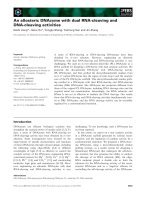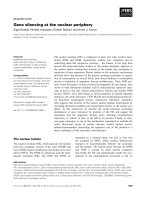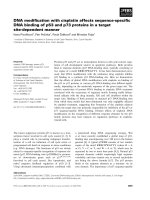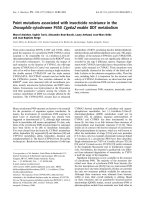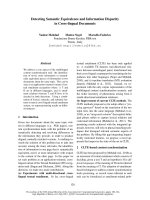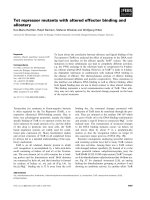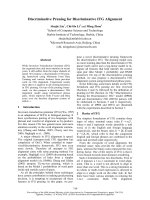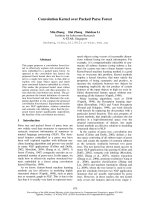Tài liệu Báo cáo khoa học: "Resolving Translation Mismatches With Information Flow" pdf
Bạn đang xem bản rút gọn của tài liệu. Xem và tải ngay bản đầy đủ của tài liệu tại đây (799.13 KB, 8 trang )
Resolving Translation Mismatches With Information Flow
Megumi Kameyama, Ryo Ochitani, Stanley Peters
The Center for the Study of Language and Information
Ventura Hall, Stanford University, Stanford, CA 94305
ABSTRACT
Languages differ in the concepts and real-world en-
tities for which they have words and grammatical
constructs. Therefore translation must sometimes
be a matter of approximating the meaning of a
source language text rather than finding an exact
counterpart in the target language. We propose a
translation framework based on Situation Theory.
The basic ingredients are an information lattice, a
representation scheme for utterances embedded in
contexts, and a mismatch resolution scheme defined
in terms of information flow. We motivate our ap-
proach with examples of translation between En-
glish and Japanese.
1
Introduction
The focus of machine translation (MT) technol-
ogy has been on the translation of sentence struc-
tures out of context. This is doomed to limited
quality and generality since the grammars of un-
like languages often require different kinds of con-
textual information. Translation between English
and Japanese is a dramatic one. The definiteness
and number information required in English gram-
mar is mostly lacking in Japanese, whereas the hon-
orificity and speaker's perspectivity information re-
quired in Japanese grammar is mostly lacking in
English. There are fundamental discrepancies in
the extent and types of information that the gram-
mars of these languages choose to encode.
An MT system needs to reason about the context
of utterance. It should make adequate assumptions
when the information required by the target lan-
guage grammar is only implicit in the source lan-
guage. It should recognize a particular discrepancy
between the two grammars, and systematically re-
act to the needs of the target language.
We propose a general reasoning-based model for
handling translation mismatches. Implicit informa-
tion is assumed only when required by the target
language grammar, and only when the source lan-
guage text allows it in the given context. Transla-
tion is thus viewed as a chain of reactive reasoning
*Linguistic Systems, Fujitsu Laboratories Ltd.
between the source and target languages. 1
An MT system under this view needs: (a) a uni-
form representation of the context and content of
utterances in discourse across languages, (b) a set of
well-defined reasoning processes within and across
languages based on the above uniform representa-
tion, and (c) a general treatment of translation mis-
matches.
In this paper, we propose a framework based on
Situation Theory (Barwise and Perry 1983). First
we will define the problem of translation mismatches,
the key translation problem in our view. Second we
will define the situated representation of an utter-
mace. Third we will define our treatment of transla-
tion mismatches as a flow of information (Barwise
and Etchemendy 1990). At the end, we will discuss
a translation example.
2 What is a
translation mismatch?
Consider a simple bilingual text:
EXAMPLE I: BLOCKS (an AI problem)
EWGLISH:
Consider the blocks world wiCh three blocks,
A, B, and C. The blocks A and B are on the table.
C
is on A. Which blocks are clear?
JAPAIIESE:
mlttu no tumaki A to B to C g~ 6ru tumild no sekLi wo
~ngaete
three of block A and B and
C NOM
exist block of world ACC consider
m/ru
try
A
to ta no tun~ki ha tnkue no
ue
A and B
of block TOPIC t&ble of &bore LOC riding
C hl A mo ue n|
notteiru
C TOPIC A
of .bore LOC riding
n&nimo ue as nottelnai tam/hi hl dote
h
nothin& above
LOC riding block TOPIC which ?
Note the translation pair
C is on A
and C t~ A ~9
_h~j~-~w~ (C ha A no .e ni nofteirn).
In En-
1 Such a reasoning-based MT system is one kind of "negotiation"-
based system, as proposed by Martin Kay. We thank him for
stimulating our thinking.
193
glish, the fact that C is on top of A is expressed
using the preposition on and verb is. In Japanese,
the noun _1= (ue) alone can mean either "on top of"
or "above", and there is no word meaning just "on
top of". Thus the Japanese translation narrows the
relationship to the one that is needed by bringing
in the verb j~-~ 77 w ~ (notteirn) 'riding'. This phe-
nomenon of the same information being attached to
different morphological or syntactic forms in differ-
ent languages is a well-recognized problem in trans-
lation.
TRANSLATION DIVERGENCES 2 of
this kind mani-
fest themselves at a particular representation level.
They can be handled by (i) STRUCTURE-TO-STRUCTURE
TRANSFERS,
e.g., structural transformations of Na-
gao (1987), the sublanguage approach of Kosaka et
al (1988), or by (ii) TRANSFER VIA A "DEEPER"
COMMON GROUND, e.g., the entity-level of Carbonell
and Tomita (1987), the lexical-conceptual structure
of Dorr (1990). A solution of these types is not gen-
eral enough to handle divergences at all levels, how-
ever. More general approaches to divergences allow
(iii) MULTI-LEVEL MAPPINGS, i.e., direct transfer
rules for mapping between different representation
levels, e.g., structural correspondences of Kaplan et
al. (1989), typed feature structure rewriting sys-
tem of Zajac (1989), and abduction-based system
of Hobbs and Kameyama (1990).
We want to call special attention to a less widely
recognized problem, that
of TRANSLATION
MISMATCHES.
They are found when the grammar of one language
does not make a distinction required by the gram-
mar of the other language. For instance, English
noun phrases with COUNT type head nouns must
specify information about definiteness and number
(e.g. a town, the town, towns, and the towns are
well-formed English noun phrases, but not town).
Whereas in Japanese, neither definiteness nor num-
ber information is obligatory. Note the translation
pair Which blocks are clear? and
f~ %_h~77
W~ W~]~Cg~
~°~
( Nanimo ne ni notteinai tnmiki
ha dore ka) above. Blocks is plural, but tnmiki has
no number information.
A mismatch has a predictable effect in each trans-
lation direction. From English into Japanese, the
plurality information gets lost. From Japanese into
English, on the other hand, the plurality informa-
tion must be explicitly added.
Consider another example, a portion of step-by-
step instructions for copying a file from a remote
system to a local system:
EXAMPLE 2:
FTP
~Thls term was taken from Dorr (1990) where the prob-
lem of divergences in verb predicate-argument structures was
treated. Our use of the term extends the notion to cover a
much more general phenomenon.
ENGLISH:
2. Type 'open', a space, and the name of the
remote systems and press [return].
The system displays system connection messages
and prompts for a user name.
3. Type the user name for your account on the
remote system and press [return].
The system displays a message about passwords
and prompts for a password if one is required.
JAPANESE:
2. open ~1~ ~ ~ b'~':~ a,~:~-'l' 7"b~ ~ y
~o
'open' kuuhaku rimooto sisutemu met wo taipu
si [RETURN]
'open' space remote system name ACC type and
[RETURN]
slsntemn setnsokn messeesi to ynnsaa reel wo ton puronputo
system connection message and user name ACC ash prompt
ga hyousi
s~reru
NOM display PASSIVE
rimooto slsutemu deno sihun no ak~unto no yuusa met
remote system
LOC SELF
of account of user name
wo t~ipu s| [RETURN] wo osu
ACC
type and
[RETURN] ACC push
pasuwaado ni
ksnsurn messeess
to, moshi pasuwaado Sa
p~ssword
about messaKe And, if password
NOM
hltuyon nara
po~suwaado wo
tou pronputo ga hyoujl sarern
required then password
ACC ask prompt NOM dlsplay PASSIVE
The notable mismatches here are the definiteness
and number of the noun phrases for "space," "user
name," "remote system," and "name" of the remote
system in instruction step 2, and those for "mes-
sage," "password," and "user name" in step 3. This
information must be made explicit for each of these
references in translating from Japanese into English
whether or not it is decidable. It gets lost (at least
on the surface) in the reverse direction.
Two important consequences for translation fol-
low from the existence of major mismatches be-
tween languages. First in translating a source lan-
guage sentence, mismatches can force one to draw
upon information not expressed in the sentence
information only inferrable from its context at best.
Secondly, mismatches may necessitate making in-
formation explicit which is only implicit in the source
sentence or its context. For instance, the alterna-
tion of viewpoint between user and system in the
FTP example is implicit in the English text, de-
tectable only from the definiteness of noun phrases
like "a/the user name" and "a password," but Japanese
grammar requires an explicit choice of the user's
viewpoint to use the reflexive pronoun zibsn.
When we analyze what we called translation di-
vergences above more closely, it becomes clear that
divergences are instances of lexical mismatches. In
the blocks example above, for instance, there is a
mismatch between the spatial relations expressed
with English on, which implies contact, and Japanese
194
ue,
which implies nothing about contact. It so hap-
pens that the verb "notteiru" can naturally resolve
the mismatch within the sentence by adding the in-
formation "on top of". Divergences are thus lexical
mismatches resolved within a sentence by coocur-
ring lexemes. This is probably the preferred method
of mismatch resolution, but it is not always possi-
ble. The mismatch problem is more dramatic when
the linguistic resources of the target language offer
no natural way to match up with the information
content expressed in the source language, as in the
above example of definiteness and number. This
problem has not received adequate attention to our
knowledge, and no general solutions have been pro-
posed in the literature.
Translation mismatches are thus a key transla-
tion problem that any MT system must face. What
are the requirements for an MT system from this
perspective? First, mismatches must be made rec-
ognizable. Second, the system must allow relevant
information from the discourse context be drawn
upon as needed. Third, it must allow implicit facts
be made explicit as needed. Are there any system-
atic ways to resolve mismatches at all levels? What
are the relevant parameters in the "context"? How
can we control contextual parameters in the transla-
tion process? Two crucial factors in an MT system
are then REPRESENTATION and REASONING.
We
will first describe our representation.
3 Representing the translation con-
tent and context
Translation should preserve the information con-
tent of the source text. This information has at least
three major sources: Content, Context, Language.
From the content, we obtain a piece of information
about the relevant world. From the context, we
obtain discourse-specific and utterance-specific in-
formation such as information about the speaker,
the addressee, and what is salient for them. From
the linguistic forms (i.e., the particular words and
structures), through shared cooperative strategies
as well as linguistic conventions, we get information
about how the speaker intends the utterance to he
interpreted.
DISTRIBUTIVE LATTICE OF INFONS.
In this approach, pieces of information, whether
• they come from linguistic or non-linguistic sources,
are represented as
infons
(Devlin 1990). For an n-
place relation P, ((P, Zl, ,z, ;1)) denotes the in-
formational item, or infon, that zl, , xn stand in
the relation P, and ((P, Zl, ,zn ;0)) denotes the
infon that they do not stand in the relation. Given
a situation s, and an infon or, s ~ ~ indicates that
the infon a is made factual by the situation s, read
s supports ~r .
Infons are assumed to form a distributive lattice
with least element 0, greatest element 1, set I of
infons, and "involves" relation :~ satisfying: 3
for infons cr and r, if s ~ cr and cr ~ r
then s ~ 1-
This distributive lattice (I, =~), together with a
nonempty set
Sit
of
situations
and a relation ~ on
Sit x I constitute an
infon algebra (see
Barwise and
Etchemendy 1990).
THE LINGUISTIC INFON LATTICE. We
propose to use infons to uniformly represent infor-
mation that come from multiple "levels" of linguis-
tic abstraction, e.g., morphology, syntax, semantics,
and pragmatics. Linguistic knowledge as a whole
then forms a distributive lattice of infons.
For instance, the English words
painting, draw-
ing, and picture are
associated with properties; call
them P1, P2, and P3, respectively. In the following
sublattice, a string in English (EN) or Japanese(JA)
is linked to a property with the SIGNIFIES relation
(written ==),4 and properties themselves are inter-
linked with the
INVOLVES
relation (=~):
EN: "picture" ~-= Pl((picture, x; 1))
EN: "painting" == P2((painting, x; 1))
EN: "drawing" == P3((drawing, x; 1))
EN: "oil painting" = P4((oil painting, x; 1~
EN: "water-color" == Ph((water-color, x; 1))
P2 ¢> P1, P3 ~ P1, P4 =P P2, PS =P P2
So far the use of lattice appears no different from
familiar semantic networks. Two additional factors
bring us to the basis for a general translation frame-
work. One is multi-linguality. The knowledge of
any new language can be added to the given lattice
by inserting new infons in appropriate places and
adding more instances of the "signifies" relations.
The other factor is grammatical and discourse-functional
notions. Infons can be formed from any theoretical
notions whether universal or language-specific, and
placed in the same lattice.
Let us illustrate how the above "picture" sublat-
tice for English would be extended to cover Japanese
words for pictures. In Japanese, ~ (e) includes both
paintings and drawings, but not photographs. It is
thus more specific than
picture
but more general
than
painting
or
drawing.
No Japanese words co-
signify with
painting
or
drawing,
but more specific
concepts have words ~
(aburae)
for P4,
(suisaiga)
for P5, and the rarely used word ~
(senbyou)
for artists' line drawings. Note that syn-
onyms co- signify the same property. (See Figure 1
for the extended sublattice.)
3We assmne that the relation =~ on infons is transitive,
reflexive, and anti-symmetric after Barwise and Etchemendy.
4This is our addition
to the infon lattice.
The SIGNIFIES
relation links the SIGNIFIER and SIGNIFIED to forrn a SIGN (de
Saussure 1959). Our notation abbreviates standard infons,
e.g., ((signifies, "picture", EN, P1; 1)) .
195
EN:"picture n
m P1 ((picture,x; I))
n
EN:-p~intins~ JA:'e m m
P6 ((e,z;
1))
((p~tnting,z; 1))P2 P3 ((drawlns,x;l)) ~ EN:Sdrawing"
R> P7
((line
dr&wing,z;1))
({oil p&intins,~c; 1))P4 P5 ((water.colorjc;1))
%%
JA:asenbyou ~
EN:~oil p~nting j EN:aw&ter.color j
JA:U&burae"
JA: =suis~lga =
Figure 1: The "Picture" Sublattice
((give, x, y, .;i))
^ ((pov, x;l))
^({look-up, s, s; 0))
^((look-down, s, m;0))
^((speaker,
s,
1))
((give, z, y, s;1))
^((pov, s;l))
A((looLup, s, x;0))
^((look-down, a, x;O))
^((spe6ker,
s;l))
({give, x, y, s;l)) ((give, z, y, s;l))
^((po., ffi;l)) ^((pov, x;z))
^((look.up, s, s;1)) ^((look-up, s, s;0))
^((look-down, s, I;O)) ^((look.down, s, s;1))
^((.p.~ker, .~11)
__~ _ JA Ukudas~ru~'"~ ~ ~ JA:~yokosu N
((~.~,
•, y,
.;1)) ((gi.~,
=, ~,
.;1))
^((pov, s~s)) ^((~o., J;s))
^((look-up, s, x;1)) ^((look.up, s, x;0))
^((look.down, s, x; 0)) ^((look-down, s, x;1))
^((speaker
s;l))
^((speaker
8;1))
Figure 2: Verbs of giving
JA: "Jr(e)" == PO((e, x; 1))
JA:
"~l~(aburae)"
== P4({oil painting, x; I})
JA:
"f#L~iU(muisaiga)" = PS((water-color, x; 1))
JA:
"W/~/l(senbyou)"
= P7{(senbyou, x; I})
P2 =~
P6,
P3 =P PS, PS =~
PI, P7 =#P
P3
Lexical differences often involve more complex prag-
matic notions. For instance, corresponding to the
English verb
give,
Japanese has six basic verbs of
giving, whose distinctions hinge on the speaker's
perspectivity and honorificity. For "X gave Y to Z"
with neutral honorificity,
ageru
has the viewpoint
on X, and
burets,
the viewpoint on Z.
Sasiageru
honors Z with the viewpoint on X, and
l~udasaru
honors X with the viewpoint on Z, and so on. See
Figure 2.
As an example of grammatical notions in the lat-
tice, take the syntactic features of noun phrases.
English distinguishes six types according to the pa-
rameters of count/mass, number, and definiteness,
whereas Japanese noun phrases make no such syn-
tactic distinctions. See Figure 3. Grammatical no-
tions often draw on complex contextual properties
such as "definiteness", whose precise definition is a
research problem on its own.
THE SITUATED UTTERANCE REPRE-
SENTATION. A translation should preserve as
far as practical the information carried by the source
text or discourse. Each utterance to be translated
gives information about a situation being described
precisely what information depends on the context
in which the utterance is embedded. We will utilize
what we call a SITUATED UTTERANCE REPRESEN-
TATION (SUR) to integrate the form, content, and
~N~ UN~:JA
=;0))
Figure 3: The "NP" Sublattice
context of an utterance. 5 In translating, contextual
information plays two key roles. One is to reduce
the number of possible translations into the target
language. The other is to support reasoning to deal
with translation mismatches.
Four situation types combine to define what an
utterance is:
Described Situation The way a certain piece of
reality is, according to the utterance
Phrasal Situation The surface form of the utter-
ance
Discourse Situation The current state of the on-
going discourse when the utterance is produced
Utterance Situation The specific situation where
the utterance is produced
The content of each utterance in a discourse like
the Blocks and FTP examples is that some situa-
tion is described as being of a certain type. This
is the information that the utterance carries about
the DESCRIBED SITUATION.
The PHRASAL SITUATION represents the
surface
form
of an utterance. The orthographic or phonetic,
phonological, morphological, and syntactic aspects
of an utterance are characterized here.
The DISCOURSE SITUATION
is
expanded here in
situation theory to characterize the dynamic as-
pect of discourse progression drawing on theories
in computational discourse analysis. It captures
the linguistically significant parameters in the cur-
rent state of the on-going discourse, s and is espe-
cially useful for finding functionally equivalent re-
ferring expressions between the source and target
languages. ¢
• reference time = the time pivot of the linguistic
SOur characterization of the context of utterance draws
on a number of existing approaches to discourse representa-
tion and discourse processing, most notably those of Grosz
and Sidner (1986), Discourse Representation Theory (Kamp
1981, Helm 1982), Situation Semantics (Barwise and Perry
1983, Gawron and Peters 1990), and Linguistic Discourse
Model (Scha and Polanyi 1988).
°Lewis (1979) discussed a number of such parameters in
a logical framework.
7Different forms of referring expressions (e.g. pronouns,
demonstratives) and surface structures (i.e. syntactic and
196
description ("then") s
• point of view = the individual from whose view-
point a situation is described ~
• attentional state the entities currently in the
focus and center of attention ~°
• discourse structural context = where the utter-
ance is in the structure of the current discourse I z
The specific UTTERANCE SITUATION contains in-
formation about those parameters whose values sup-
port indexical references and deixes: e.g., informa-
tion about the speaker, hearer(s), the time and loca-
tion of the utterance, the perceptually salient con-
text, etc.
The FTP example text above describes a situation
in which a person is typing commands to a com-
puter and it is displaying various things. Specif-
ically, it describes the initial steps in copying a
file from a remote system to a local system with
ftp. Consider the first utterance in instruction step
~uttering, x, u, t; 1 ~ ^ ~addressing,
~, y, t; 1
Note that the parameter y of DeS for the user
(to whom the discourse is addressed) has its value
constrained in US; the same is true of the param-
eter t for utterance time. Similarly, the parameter
r of DeS for the definite remote system under dis-
cussion is assigned a definite value only by virtue of
the information in DiS that it is the unique remote
system that is salient at this point in the discourse.
This cross-referencing of parameters between types
constitutes further support for combining all four
situation types in a unified SUR. In order for the
analysis and generation of an utterance to be as-
sociated with an SUIt, the grammar of a language
should be a set of constraints on mappings among
the values assigned to these parameters.
4 Translation as information flow
3 repeated here:
Type the
user name for your
d , - ~ Translation must often be a matter of approxi-
accoun~
on ~ne remo~e system
an press Lre~urnj
It occurs in a type of DISCOURSE SITUATION where mating the meaning oI a source mnguage ~ex~ ramer
than finding an exact counterpart in the target lan-
there has previously been mention of a remote sys-
tem and where a pattern has been established of
alternating the point of view between the addressee
and another agent (the local computer system). We
enumerate below some of the information in the
SUl~ associated with this utterance.
The Described Situation (DES) of the utterance is
~type, y,n,t~;1 ~ A ~press, y,k,tl~;1 ~ where n
satisfies n = n I ~=~ ~named, a, n~; 1 ~ a satisfies
~account, a, y,r; 1 ~ r satisfies ~system, r; 1
A ~'~remotefrom, r,y;1 ~tlsatisfies~later, t~,t;1 ~'n ,
k satisfies ~named,k,[return];l~ t satisfies ~later, t , t ; 1
The Phrasal Situation (PS) of the utterance is
~language, u,English; 1 ~ ^ ~written, u, "Type
the
user name for your account on the remote system and
press [return]."; 1 ~ ^ ~syntax, u,{ ~written, e,
"the
user name"; 1 ~ ^ ~np, e; 1 ~ ^ ~deflnite, e; 1 ~,
A ~singular, e; 1 ~ ^ }; 1
The Discourse Situation (DIS) is
r = r ~ ~ ~focus, el,remote system; 1 ~,
Finally, the Utterance Situation (US) is
phonetic) often carry equivalent discourse functions, so ex-
plicit discourse representation is needed in translating these
forms. See also Tsujil (1988) for this point.
s Reichenb~.h (1947) pointed out the significance of refer-
ence time, which in the FTP example accounts for why the
addressee is to press [return] after typing the user name of
his/her remote a~count.
9 Katagiri (to appear) describes how this parameter inter-
acts with Japanese grammar to constrain use of the reflexive
pronoun
zibu~.
10 See Grosz (1977), Grosz et al. (1983), Kameyama (1986),
Brennan et al. (1987) for discussions of this parameter.
llThis parameter may be tied to the "intentional" aspect
of discourse as proposed by Grosz and Sidner (1986). See,
e.g., Scha and Polanyi (1988) and Hobbs (1990) for discourse
structure models.
guage since languages differ in the concepts and
real-world entities for which they have words and
grammatical constructs.
In the cases where no translation with exactly the
same meaning exists, translators seek a target lan-
guage text that accurately describes the same real
world situations as the source language text. 12 The
situation described by a text normally includes ad-
ditional facts besides those the text explicitly states.
Human readers or listeners recognize these addi-
tional facts by knowing about constraints that hold
in the real world, and by getting collateral informa-
tion about a situation from the context in which a
description is given of it. For a translation to be
a good approximation to a source text, its "fleshed
out" set of facts the facts its sentences explicitly
state plus the additional facts that these entail by
known real-world constraints should be a maximal
subset of the "fleshed out" source text facts.
Finding a translation with the desired property
can be simplified by considering not sets of facts
(infons) but infon lattices ordered by involvement
relations including known real-world constraints. If
a given infon is a fact holding in some situation,
all infons in such a lattice higher than the given
one (i.e., all further infons it involves) must also
be facts in the situation. Thus a good translation
can be found by looking for the lowest infons in the
lattice that the source text either explicitly or im-
plicitly requires to hold in the described situation,
and finding a target language text that either ex-
plicitly or implicitly requires the maximal number
12In some special cases, translation requires mapping be-
tween different hut equivalent real world situations, e.g., cars
drive on different sides of the street in Japan and in the US.
197
of them to hold. 13
THE INFORMATION FLOW GRAPH. Trans-
lation can be viewed as a flow of information that re-
sults from the interaction between the grammatical
constraints of the source language (SL) and those
of the target language (TL). This process can be
best modelled with information flow graphs (IFG)
defined in Barwise and Etchemendy 1990. An IFG
is a semantic formalization of valid reasoning, and is
applicable to information that comes from a variety
of sources, not only linguistic but also visual and
other sensory input (see Barwise and Etchemendy
1990b). By modelling a treatment of translation
mismatches with IFGs, we aim at a semantically
correct definition that is open to various implemen-
tations.
IFGs represent five basic principles of information
flow:
Given Information present in the initial assump-
tions, i.e., an initial "open case."
Assume Given some open case, assume something
extra, creating an open subcase of the given
case.
Subsume Disregard some open case if it is sub-
sumed by other open cases, any situation that
supports the infons of the subsumed case sup-
ports those of one of the subsuming cases.
Merge Take the information common to a number
of open cases, and call it a new open case.
Recognize as Possible Given some open case, rec-
ognize it as representing a genuine possibility,
provided the information present holds in some
situation.
RESOLVING MISMATCHES. First~ a trans-
lation mismatch is recognized when the generation
of a TL string is impossible from a given set of in-
fons. More specifically,
given a Situated Utterance Representation
(SUIt), when no phrasal situations of TL
support SUR because no string of TL sig-
nifies infon a in SUR, The TL grammar
cannot generate a string from SUR, and
there is a
TRANSLATION MISMATCH on 0 r.
A translation mismatch on ~, above is resolved in
one of two directions:
Mismatch Resolution by Specification:
Assume a specific case r such that r =:~
and there is a Phrasal Situation of TL that
supports v. A new open case SUR' is then
generated, adding r to SUR.
13As more
sophisticated translation is
required, We could
make use of the multiple situation types to give more impor-
tance
to some aspects
of translation than others depending
on the
purpose of
the text
(see Hauenschild (1988) for such
translaion needs).
This is the case when the Japanese word ~ (e) is
translated into either
painting
or
drawing
in English.
The choice is constrained by what is known in the
given context.
Mismatch Resolution by Generaliza-
tion: Assume a general case r such that a
=~ r and there is a Phrasal Situation of TL
that supports r. A new open case SUR' is
then generated, adding 7- to SUR.
This is the case when the Japanese word ~ (e) is
translated into
picture
in English, or English words
ppainting
and
drawing
are both translated into
(e) in Japanese. That is, two different utterances
in English,
I like this painting
and
I like this draw-
ing,
would both be translated into ~J~l'~ ~ Otl~ff
~'~ (watasi wa kono e ga suki desn)
in Japanese
according to this scheme.
Resolution by generalization is ordinarily less con-
strained than resolution by specification, even though
it can lose information. It should be blocked, how-
ever, when generalizing erases a key contrast from
the content. For example, given an English utter-
ance,
I like Matisse's drawings better than paintings,
the translation into Japanese should not generalize
both
drawings
and
paintings
into ~ (e) since that
would lose the point of this utterance completely.
The mismatches must be resolved by specification in
this case, resulting in, for instance, $J~1"~'¢~" 4 gO
~tt~e~A~ ]: 9 ~ ~t~ ~'t?'J" ( watasi wa Ma-
tisse no abnrae ya snisaiga yorimo senbyou ga suki
dest 0
'I like Matisse's line_drawings(P7) better than
oil_paintings(P4) or water-colors(P5)'.
There are IFGs for the two types of mismatch
resolution. Using o for an open (unsubsumed) node
and • for a subsumed node, we have the following:
Mismatch Resolution by Specification: (given r :~ a)
Given: o{a} Assume: ?{a}
/
6{¢,
~}
Mismatch Resolution by Generalization: (given o" :¢, ¢)
Given: o{a} Assume:
l{a} Subsume: l{a}
6{¢,¢} ~{q,T}
Both resolution methods add more infons to the
given SUR by ASSUMPTION, but there is a differ-
ence. In resolution by specification, subsequent sub-
surnption does not always follow. That is, only by
contradicting other given facts, can some or all of
the newly assumed SUR's later be subsumed, and
only by exhaustively generating all its subcases, the
original SUR can be subsumed. In resolution by
generalization, however, the newly assumed general
case immediately subsumes the original SUR. 14
14Resolution by specification
models a form of abductive
inference, and generalization, a form of deductive inference
198
Source Language Target L~ngu@ge
Discourse
Situations
DiS 1
DiS m
Utterance
Situations
US 1 USI
Phrasal
Situations
PS 1 PS k
Discourse
Situations
~is i Dis~,
Utterance
Situations
~s i ~s i,
Phrasal
Situations
Psi Psi,,
Figure 4: Situated Translation
THE TRANSLATION MODEL. Here is our
characterization of a TRANSLATION:
Given a SUR ( DeT, PS, DiS, US ) of
the nth source text sentence and a dis-
course situation DiS" characterizing the
target language text following translation
of the (n-1)st source sentence, find a SUR
( DeT', PS ~, DiS ~, US ~) allowed by the tar-
get language grammar such that DiS" _C
DiS ~ and
( DeT, PS, DiS, US ) ,~ ( DeT s, PS s, DiS ~, US').
(N is the approximates relation we have
discussed, which constrains the flow of in-
formation in translation.)
Our approach to translation combines SURs and
IFGs (see Figure 4). Each SUR for a possible inter-
pretation of the source utterance undergoes a FLOW
OF TRANSLATION as follows: A set of infons is ini-
tially GIVEN in an SUR. It then grows by mismatch
resolution processes that occur at multiple sites un-
til
a generation of a TL string is
RECOGNIZED
AS
POSSIBLE. Each mismatch resolution involves AS-
SUMING new SUR's and SUBSUMING inconsistent or
superfluous SUR's. ~s
Our focus here is the epistemologicai aspect of
translation, but there is a heuristically desirable
property as well. It is that the proposed mismatch
resolution method uses only so much additional in-
formation as required to fill the particular distance
between the given pair of linguistic systems. That
is, the more similar two languages, leas computa-
tion. This basic model should be combined with
various control strategies such as default reasoning
in a sltuation-theoretic context. One way to implement these
methods is in the abduction-based system proposed by Hobbs
and Kameyama (1990).
~SA possible use of MERGE in this application is that two
different SUit's may be merged when an identical TL string
would be generated from them.
((count,.x.zx)) ~p5 ((de~,x;o))
Uthe user name N athe user
n&mes u ua user name ~ ~user nlLmesn
Figure 5: The IFG for NP Translation
in an actual implementation.
5 A
translation example
We will now illustrate the proposed approach with
a Japanese-to-English translation example: the first
sentence of instruction step 3 in the FTP text.
INPUT STRING: "3. ~ -~' ]- ":/.~ ~'J-~'C'~'J ~'ff)7"
~/~= ~~" 7"L~ ~ y~9-o "
1. In the initial SUR are infons for 9 -~ b ":I ~ ~"
(rimoofo sisutemu)
'remote system', 7' ~
:I i. (akaunfo)
'account', and :' '~
(yu~zaa
mei) 'user name'. All of thesewords signify
properties that are signified by English
COUNT
nouns but the Japanese SUR lacks definiteness
and number information.
2. Generation of English from the SUR fails be-
cause, among other things, English grammar
requires NPs with COUNT head nouns to be of
the type, Sg-Def, Sg-Indef, PI-Def, or Pl-Indef.
(translation mismatch)
3. This mismatch cannot be resolved by general-
ization. It is resolved by assuming four sub-
cases for each nominal, and subsuming those
that are inconsistent with other given informa-
tion. The "remote system" is a singular entity
in focus, so it is Sg-Def, and the other three
subcases are subsumed. The
"user
name" is
an entity in center, so Definite. The "account"
is Definite despite its first mention because its
possesser (addressee) is definite. Both "user
name" and "account" can be either Singular or
Plural at this point. Let's assume that a form
of default reasoning comes into play here and
concludes that a user has only one user name
and one account name in each computer.
4. The remaining open case permits generation of
English noun phrases, so the translation of this
utterance is done.
OUTPUT STRING:
"Type the user name for your
account on the remote system and "
6 Conclusions
In order to achieve high-quality translation, we
need a system that can reason about the context of
utterances to solve the general problem of transla-
199
tion mismatches. We have proposed a translation
framework based on Situation Theory that has this
desired property. The situated utterance represen-
tation of the source string embodies the contextual
information required for adequate mismatch reso-
lution. The translation process has been modelled
as a flow of information that responds to the needs
of the target language grammar. Reasoning across
and beyond the linguistic levels, this approach to
translation respects and adapts to differences be-
tween languages.
7 Future implications
We plan to design our future implementation of
an MT system in light of this work. Computational
studies of distributive lattices constrained by multi-
ple situation types are needed. Especially useful lin-
guistic work would be on grammaticized contextual
information. More studies of the nature of transla-
tion mismatches are also extremely desirable.
The basic approach to translation proposed here
can be combined with a variety of natural language
processing frameworks, e.g., constraint logic, ab-
duction, and connectionism. Translation systems
for multi-modal communication and those of multi-
ple languages are among natural extensions of the
present approach.
8 Acknowledgements
We would like to express our special thanks to
Hidetoshi Sirai. Without his enthusiasm and en-
couragement at the initial stage of writing, this pa-
per would not even have existed. This work has
evolved through helpful discussions with a lot of
people, most notably, Jerry Hobb8, Yasuyoshi Ina-
gaki, Michio Isoda, Martin Kay, Hideo Miyoshi, Hi-
roshi Nakagawa, Hideyuki Nakashima, Livia Polanyi,
and Yoshihiro Ueda. We also thank John Etchemendy,
David Israel, Ray Perrault, and anonymous review-
ers for useful comments on an earlier version.
References
[1] Barwise, Jon and John Etchemendy. 1990. Information, In-
fons, and Inference. In Cooper et ai. (eds), 33-78.
[2] Barwise, Jon and John Etchemendy. 1990b. Visual Informa-
tion and Valid Reasoning. In W. Zimmerman (ed.) Visualiza-
tion in Mathematics. Washington DC: Mathematical Associ-
ation of America.
[3] Barwise, Jon, and John Perry. 1983. Situations and Atti-
tudes. Cambridge, MA: MIT Press.
[4] Brennan, Susan, Lyn Friedman, and Carl Pollard. 1987. A
Centering Approach to Pronouns. In Proceedings of the 25th
Annual Meeting of the Association for Computational Lin-
guistics, Cambridge, MA: ACL, 155-162.
[5] Carbonell, Jaime G. and Masaru Tomita. 1987. Knowledge-
based Machine Translation, the CMU Approach. In Nirenburg
(ed.),
68-89.
[6] Cooper, Robin, Kuniaki Mukai, and John Perry (eds) 1990.
Situation Theory and Its Applications, Volume 1, CSLI Lec-
ture Notes Number 22. Stanford: CSLI Publications.
[7] Devlin, Keith. 1990. lnfons and Types in an Information°
Based Logic. In Cooper et el. (eds), 79-96.
[8] Dorr, Bonnie. 1990. Solving Thematic Divergences in Ma-
chine Translation. In Proceedings of the £8th Annual Meet-
ing of the Association for Computational Linguistics, Pitts-
burgh, PA, 127-134.
[9] Gawron, J. Mark and Stanley Peters. 1990. Anaphora and
Quantification in Situation Semantics, CSLI Lecture Notes
Number 19. Stanford: CSLI Publications.
[10] Grosz, Barbara. 1977. The Representation and Use of Fo-
cus in Dialogue Understanding. Technical Report 151, SPA
International, Menlo Park, CA.
[11] Grosz, Barbara J., Aravind K. Joshi, and Scott Weinstein.
1983. Providing a Unified Account of Definite Noun Phrases
in Discourse. In Proceedings of the £1st Annual Meeting of
the Association for Computational Linguistics, Cambridge,
MA, 44-50.
[12] Grosz, Barbara J. and Candace L. Sidner. 1986. Atten-
tion, Intention, and the Structure of Discourse. Computa-
tional Linguistics, 12(3), 175-204.
[13] Hauenschild, Christa. 1988. Discourse Structure - Some Im-
plications for Machine Translation. In Maxwell et el. (eds),
145o156.
[14] Heim, Irene R. 1982. The Semantics of Definite and In-
definite Noun Phrases. PhD dissertation, University of Mas-
sachusetts at Amherst.
[151 Hobbs, Jerry. 1990. Literature and Cognition. CSLI Lec-
ture Note Number 21. Stanford: CSLI Publications.
[16] H0bbs, Jerry and Megumi Karneyama. 1990. Translation by
Abduction. In Proceedings of the 13th International Confer-
ence on Computational Linguistics, Helsinki, Finland.
[17] Kameyama, Megumi. 1986. A Property-sharing Constraints
in Centering. In Proceedings of the £4th Annual Meeting of
the Association for Computational Linguistics, Cambridge,
MA: ACL, 200-206.
[18] Kemp, Hans. 1981. A Theory of Truth and Semantic Rep-
resentation. In 3. Groenendijk, T. Jansaen, and M. Stokhof
(eds), Formal Methods in the Study of Language. Amster-
dam: Mathematical Center.
[19] Kaplan, Ronald M., Klaus Netter, Jiirgen Wedekind, and
Annie Zaenen. 1989. Translation by Structural Correspon-
dences. In Proceedings of the 4th Conference of the European
Chapter of the Association for Computational Linguistics,
Manchester, United Kingdom, 272-281.
[20] Katagiri, Yasuhiro. To appear. Structure of Perspectivity:
A Case of Japanese Reflexive Pronoun "zibun". Paper pre-
sented at STASS-90, Scotland.
[21] Kosaka, Michiko, Virginia Teller, and Ralph Grishman. 1988.
A Sublanguage Approach to Japanese-English Machine Trans-
lation. In Maxwell et ai. (eda), 109-122.
[22] Lewis, David K. 1979. Scorekeeping in Language Game. In
B~uerle, R., U. Egli and A. yon Stechow (eds) Semanticsyrom
Different Points of View. Berlin: Springer Verlag.
[23] Maxwell, Dan, Klaus Schubert, and Toon Witkam (eds).
1988. New Directions in Machine 7PanMation. Dordrecht,
Holland: Foris.
[24] Nagan, Makoto. 1987. The Role of Structural Transforma-
tion in a Machine Translation System. In Nirenburg (ed.),
262-277.
[25] Nirenburg, Sergei (ed.) 1987. Machine Translation. Cam-
bridge: Cambridge University Press.
[26] Reichenbach, Hans. 1947. Elements of Symbolic Logic. New
York: Dover.
[27] de Saussure, Ferdinand. 1959. Course in General Linguis-
tics. Edited by Charles Belly and Albert Sechehaye in collab-
oration with Albert Riedlinger. Translated by Wade Baskin.
New York: McGraw-Hill.
[28] Scha, Remko and Livia Polanyi. 1988. An Augmented Context-
free Grammar of Discourse. In Proceedings of the l~th In-
ternational Conference on Computational Linguistics, Bu-
dapest, Hungary.
[29] Tsujii, Junoichi. 1988. What is a Croas-linguisticaily Valid
Interpretation of Discourse? In Maxwell et el. (eds), 157-166.
[30] Zajac, Remi. 1989. A Transfer Model Using a Typed Fea-
ture Structure Rewriting System with Inheritance. In Pro-
ceedings of the ~Tth Annual Meeting of the Association for
Computational Linguistics, Vancouver, Canada.
200
